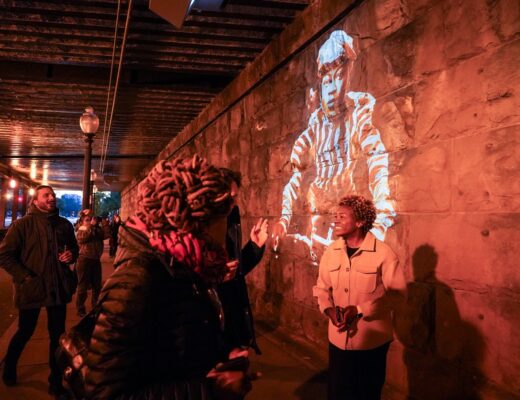By Thais Carrion
This article was first published August 7, 2022 in DC Trending here.
This past June, the National Gallery of Art celebrated the re-opening of I. M. Pei’s light-filled East Building, following a series of renovations and structural changes that have been taking place since its most recent closure in February of this year. The exhibition chosen to inaugurate the iconic space is Margaret MacDonald, Anne Dumas and Charles Brock’s The Woman in White: Joanna Hiffernan and James McNeill Whistler, a beautiful and essential exploration of Whistler’s most important subject, Joanna Hiffernan. On view through October 10th, Whistler’s many depictions of Hiffernan provide an exquisite impressionist contrast to the bold colors of Rothko and random splatters of Pollock currently housed in the East Building’s permanent collection.
Few gallery spaces are as dynamic and visitor-centered as the National Gallery of Art’s East Building, whose quirky trapezoidal shape and abundance of light has seen important infrastructural changes with the new renovations. With Pei’s original vision at the forefront of renovation initiatives, new skylights have been installed to both filter out paint-harming UV rays and restore the level of light within the building to what it was at its opening in 1978. New galleries have been installed, as well, to house the growing permanent collection and temporary exhibits that find themselves within the East Building.
“I’ve always found this building very uplifting and full of life. The architecture is very movement-oriented and the way the light enters the building is truly special,” says Susan Wartheim, Chief Architect, National Gallery of Art.
With the integrity of the building as a work of art in and of itself at the center of the renovations, the gallery has been transformed into a more technologically modern, accessible space. In contrast to the symmetrical, rectangular galleries of the neoclassical West building, the dynamism of the East building provides open gallery spaces full of personality. “As an architect, I think the architecture and the modern art really go well together,” says Wartheim, “there’s undeniably a conversation taking place between the East and the West [buildings]”.
This conversation takes place between the art and architecture within the East building as well, with James McNeill Whistler’s white-clad muse in The Woman in White reminiscent of the light-filled atrium just outside the three connecting rooms that make up the exhibition. “It’s very intriguing to put 19th century art in modern galleries like the East building because it gives [the public] a new perspective on how relevant they are to modern design and certainly that’s the case with this [exhibition], ” says Charles Brock, Associate Curator of The Woman in White exhibit.
Filled with ethereal white dresses and her signature wild red hair, The Woman in White, is Margaret Macdonald, Anne Dumas, and Charles Brock’s attempt to piece together the human behind Whistler’s depictions of Hiffernan and to explore the resonance of Whistler and Hiffernan’s collaboration for Victorian culture as a whole in the late 19th century. Posed just at the entrance to the exhibition, Hiffernan stares out at her voyeurs atop the menacing skin of a wolf in Symphony in White Number 1, the wild eyes of the dead animal at her feet seemingly acting as a vessel for whatever hidden emotions run beneath Hiffernan’s composed surface. Despite the curator’s best efforts, Joanna remains at arm’s length throughout the exhibition, which ends up revealing more about Whistler’s gaze than the subject herself.
The curators have done an excellent job at taking Whistler off his pedestal and asking questions about the nature of his relationship with Hiffernan throughout. The audience is included as an active investigator throughout the exhibit with wall texts urging us to consider Joanna Hiffernan beyond Whistler’s portrayals and to “discern a difference between the ‘real’ Hiffernan and a model playing a role” (wall text). Regardless of Whistler’s own reputation and importance within the world of art, the curators make it clear that none of his standings would be possible without his most important muse.
Furthermore, once having seen what influence Hiffernan held in other impressionist and modern works of her time period, one can hardly help but ask how it is possible that so little is known, or available about her today. As part of the reclaiming of Hiffernan’s agency as a collaborator in Whistler’s art, the exhibition includes a dedicated wall containing quotes from DC area models that speak to the ironically anonymous position they hold within the world of art and creation. This through-line drawn to illustrate the continuity of the anonymity imposed upon Hiffernan despite her central role in the various artworks displayed throughout the exhibition is powerful, and draws on her historical position to inform viewers of the model’s silent role today.
The collaboration between the stunning improvements to the East Building’s lighting and facilities, as well as MacDonald, Dumas, and Brock’s audience-centered investigative exhibition, results in the reclaiming of the East Building as a space made for congregation, a building with the enjoyment of its visitors at the forefront of its infrastructure. “To see [Hiffernan’s] image at such a large scale within the very modern spaces of the East Building speaks very eloquently to the point of the exhibition,” says Brock.
The East Building’s wide open spaces, fascinating geometric layout, its natural feel brought forth through gentle sunlight, and the ficus trees planted into the ground all act in conversation with the modern and contemporary art housed within its walls, a conversation that places the audience and their participation as a key figure. The Woman in White is one of the first of its kind, an exhibition that encourages museum-goers to look past the supposed genius of its painter and instead take part in the search for humanity within the subjects of the paintings themselves.





No Comments